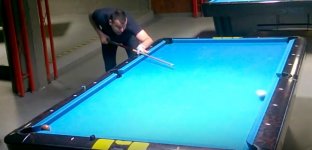Hi.
I thought id´d add something because kicking is my area of excellence at pool. I post to Youtube mostly races against ghost and 14.1 runs so there is only little kicking there.
I made video earlier about 1 rail kicks(also 2 rail and about 3 rail opposite system too).
I also have video where i "drill" kicks so one can see how accurate that is.
That said, I´m not happy about video(and sound) quality. I gonna either make new audio and cut original little or make whole thing again and make audio afterwards so I can put better quality.
I´d also would do these videos better rails(I can do better accuracy and better cushions give also more margin of error to spin) because these tables are 25 years old and they have cushions replaced couple of times and they are not good ones.
They play quite short.
System I use is reference. Master particular kicks and expand from there. My 1 rail system basic uses fast speed and centerball because it is really close at any table. Of course there is more but i don´t wanna write all here.
If someone is interested here is links:
drilling kicks: first i do my base lines. then about 6:40 i try clear table full of balls randomly to one pocket... in the end i put some 2 railers too.
https://www.youtube.com/watch?v=ZTiFGkDoGK8
Reference kicking: Where is try teach this shit
 https://www.youtube.com/watch?v=eW4Q5debhFk
https://www.youtube.com/watch?v=eW4Q5debhFk
The thing about reference kicking is that´s simple to use even under pressure and lack of time. So it will work at tournaments too(with shotclock even).
